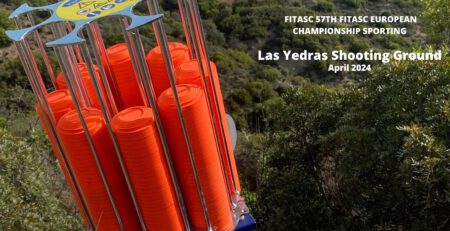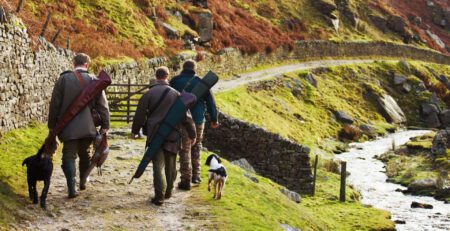CLAY SHOOTING GUIDE FOR BEGINNERS. EVERYTHING YOU NEED TO KNOW IF YOU WANT TO GET STARTED IN THIS SPORT
If you are thinking of starting the new year with a new sport, what better way to do it than with a beginner’s guide to clay shooting that will teach you everything you need to know if you want to get started in this sport.
This is not intended to be a definitive and unique guide, but we do want to give you the basics that will help you when making your first decisions about the equipment you will need, the existing modalities or safety rules.
Apart from some tips, of course.
So don’t miss it and take good note of everything you need.
MODALITIES OF CLAY PIGEON SHOOTING: EXPLORING VARIETY
As we explained in our blog article “clay target shooting: Olympic and sporting modalities“, the disciplines of clay shooting are divided, precisely, between these two disciplines.
Sporting shooting includes numerous modalities, among which Universal Trench, DTL (Down the line), Compak Sporting and Sporting.
Olympic shooting includes modalities such as the Olympic Trap, Double Trap or Skeet.
Exploring these disciplines will not only broaden your experience as a shooter, but also provide you with a range of opportunities to hone various marksmanship and adaptability skills.
Let’s look at each of these disciplines a little more in depth.
UNIVERSAL TRENCH
It is one of the sporting disciplines in which the shooter must always be alert to be able to act quickly, so it is necessary to have a very good composure and technique, which makes it one of the favourites of the most experienced shooters.
But do not think that it is a discipline that you should be discarded in advance.
Practising it will surely make you discover skills you thought you didn’t have.
Briefly, we will tell you that this modality consists of 5 shooting stations where the shooters receive the targets launched from the 5 machines installed in a pit located in front of them.
The trajectories of the targets vary from one shooter to another, but they all shoot the same number of targets at the end of each round, which consists of 8 series with a total of 200 targets, that is, 25 targets for each series.
DTL (DOWN THE LINE)
Very popular in Australia, New Zealand, South Africa and Zimbabwe, among others, this modality consists of 5 shooting posts in the shape of a crescent moon, placed 16 yards away from the trap machine.
Each shooter must shoot from each of the shooting positions consecutively. That is to say, he/she may start at any of the shooting posts and must move to the next one until all five are completed.
COMPAK SPORTING
Undoubtedly, the most practised discipline by hunting lovers. If you are one of them, surely you already know it.
On this occasion, from the 5 shooting posts that make up a Compak Sporting field, targets are launched with highly variable trajectories, which try to simulate the unexpected trajectories of game species, making it one of the most exciting modalities.
If you like challenges, this is your discipline.
SPORTING
If you are a lover of small game, this may be your best option.
It takes place in large extensions of land with ravines, vegetation and tree masses, which hide the flight of the target from the shooter to obtain greater realism and difficulty.
The shooting positions, the number of trap machines and the trajectories of the targets will depend on the extension of the terrain.
OLYMPIC TRAP
This is the Olympic modality that we are sure you already know.
6 shooters are arranged in the 5 shooting stations (one on standby) and will rotate to shoot at the targets launched from each of the trap machines: 5 per shooting station and 15 in total.
DOUBLE TRAP
Reaction and speed are the main characteristics that define shooters in this discipline.
Each shooter must shoot at two targets launched at the same time with divergent trajectories. So, if you want to get good results practicing this modality, you must be quick and fast.
Once on the shooting range, you will have three machines located in a pit in front of the shooting posts, each of which will shoot two targets simultaneously.
Quite a challenge!
SKEET
Do you know where its name comes from? In 1926, a U.S. shooting magazine offered $100 to whoever could find a name for this discipline. “Skeet,” derived from the Norwegian “shooting,” won.
Discipline that simulates the shots that upland hunters encounter in the field.
A Skeet shooting range consists of two stands, one high and one low, at each end of a semicircle composed of 8 shooting positions. Starting with the high stand, shooters move through 7 positions around the semicircle, firing a set combination of shots at each shooting stand. The number 8 position is placed between the high stand and the low stand, and the final shots require the shooter to break a plate shot from each.
Exciting, isn’t it?
EQUIPMENT NECESSARY FOR CLAY PIGEON SHOOTING
Don’t panic! You won’t need to buy all the recommended equipment for clay target shooting before you start practising for the first time, but we do want to detail all the recommended equipment for this sport.
From the most essential, such as the shotgun, to the most basic, such as clothing.
The main thing is that you can practice your favourite sport in complete safety.
SHOTGUNS FOR CLAY TARGET SHOOTING
For those new to clay target shooting, single-barrel shotguns and semiautomatics are fairly popular choices. Single-barrel shotguns are known for their simplicity and low cost, while semi-automatics offer a quick succession of shots without the need for manual reloading.
The most recommended calibers for beginners are the 20 and 12 gauge. The 20 gauge is known for having less recoil, being more comfortable for beginners, while the 12 gauge offers a wider variety of cartridges available.
If in doubt when choosing your shotgun, always consider factors such as weight, length and grip. Try different models and seek expert advice to help you find the shotgun that best suits your individual preferences and needs.
Before you decide to buy your own shotgun, for which you will need to obtain an E type gun license, try a few classes. Most gun clubs have an exemption that allows non-license holders to shoot with someone who holds a range officer’s certificate.
SHOOTING HELMETS AND EYE PROTECTION
Did you know that the chances of suffering from deafness increase up to 4 times in hunters and shooters with respect to the rest of people who do not practice hunting or clay target shooting?
That is why it is so important to wear hearing and eye protection at all times during practice and competition.
Hearing and eye protection are essential to prevent injuries caused by noise and target fragments, as well as to help us extend our shooting practice by helping to mitigate hearing fatigue.
To protect your ears, you can choose between earplugs and noise reduction headphones. Earplugs are more compact and lightweight, while headphones provide greater coverage and comfort.
Always look for the option that best suits you and be sure to adjust it to your needs to gain in comfort.
APPROPRIATE CLOTHING
Clay target shooting clothing should be comfortable and allow you to move without any restrictions.
You will not need specific pants or sweaters, although we do recommend that you wear appropriate footwear and a specific shooting vest.
Shooting vests provide compartments for cartridges and facilitate quick access to ammunition.
Proper footwear provides stability and traction in various range terrain conditions. Sturdy boots would be the most appropriate choice to provide you with additional support.
It may also be advisable to use reflective vests and protective caps as additional items, which not only contribute to safety, but also improve visibility on the shooting range.
SAFETY RULES, YOUR PRIORITY IN CLAY TARGET SHOOTING
Clay target shooting, as you can imagine, is a sport that cannot be taken lightly. The first rule, and the most fundamental, is precisely to know all the existing safety rules from the first minute you arrive at the shooting range.We have already talked about this in several articles of our blog. Today we leave here the most important ones to avoid any kind of problem.
Basic Rules at the Range
- Safe Behavior: always follow proper guidelines to maintain a safe and respectful shooting environment.
- Responsible Gun Handling: don’t neglect the guidelines on how to handle shotguns safely and ethically.
- Field etiquette: learn how to communicate with other shooters and always respect the rules of the range.
Tips to Avoid Accidents
- Safe Gun Storage: Do not neglect the rules for storing and transporting your shotgun in the safest way.
- Equipment Pre-Inspection: it is vitally important that you regularly check your equipment to ensure it is in good working order.
- Effective Communication on the Range: learn how clear communication can prevent misunderstandings and dangerous situations.
SOME TIPS FOR STARTING YOUR TRAINING SESSIONS
Constant training is fundamental to improve your clay target shooting. That’s why we want to give you some tips to help you learn how to get the most out of your training sessions:
- Practice regularly at a shooting range. Find a nearby range and schedule regular training sessions. Participate in local events and competitions to gain experience and meet other shooters.
- Work on your technique and position. Pay attention to your stance, grip and eye tracking while aiming and shooting. Work on your hand-eye coordination to improve your accuracy.
- Learn to anticipate the target. Watch the trajectory of the targets and train your ability to anticipate their movement. Practice shooting different types of targets to become familiar with their velocities and trajectories.
- Control the recoil of the shotgun. Recoil can be intimidating for beginners. Work on your grip technique and position to reduce its impact. Gradually, you will get used to the recoil and learn to handle it better with practice.
- Improve accuracy. Accuracy is critical in clay target shooting. Practice aiming and visual tracking to improve your skills. Work on your concentration and breathing to stay calm while shooting.
- Stay motivated. Clay shooting can present challenges, but it also brings satisfaction. Set achievable goals and celebrate your accomplishments. Join online communities or clay shooting clubs to connect with other shooters and share experiences.
Yes, it seems like a lot of information at first, so if all this seems too complicated for you to do on your own, we recommend that you look for a club near your home, with professionals who will help you with your progress and guide you so that, little by little, you will learn everything you need to know about this sport.
Look for a club with experienced and qualified instructors who will guide you properly. Instructors will teach you the correct techniques, provide advice and help you develop the necessary skills to become a successful shooter. Look for reputable clay shooting schools in your area and read reviews from other shooters to make sure you find a reliable and competent instructor.
Now that you have all the information you need to know about the sport, are you going to take the plunge and put it into practice this year?
If you do so, we would love to hear about your experience.












